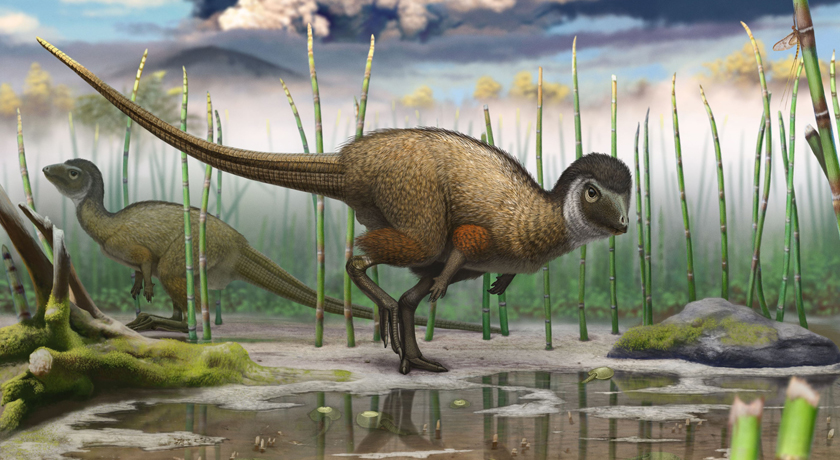Feathers: What every dino wore?
A newly identified species had both scales and feathers

This artist's rendering shows what the newly identified dino might have looked like, moving through its environment.
ANDREY ATUCHIN
All dinosaurs may have worn feathered coats. Fossils recently found in Siberia add more support to that idea, which is gaining ground among scientists.
Scientists had previously found evidence that some dinos and dino-like birds had feathers. Newly unearthed dinosaur skulls and bones from Siberia now suggest feathers had been the norm, not the exception. The fossils came from a creature with both scales and feathers.
Most paleontologists suspect dinosaurs adapted, or evolved slowly over many generations, into modern birds. (Indeed, some scientists even refer to birds as flying dinosaurs.) The discovery of feathers on ancient fossils now supports that link between dinos and birds. But the newfound species differs from earlier discoveries. It is only distantly related to that branch of the dinosaur family tree that would give rise to modern birds.
“For the first time we have a feathered dinosaur that is far from the lineage leading to birds,” Pascal Godefroit told Science News. He’s a paleontologist at the Royal Belgian Institute of Natural Sciences in Brussels. Finding a fluffy dino only distantly related to birds “means that all dinosaurs were potentially covered by feathers,” he said.
The feathered dinos that had been discovered earlier include one creature with a fluffy, feathery tail. However, all of those earlier dinosaurs were theropods. This group includes meat-eaters like T. Rex and the megalosaurs. Theropods most likely gave rise to modern birds.
The fossils discovered by Godefroit and his colleagues are not from a theropod. They came from a creature on the branch of the dinosaur family tree known as ornithischians. This group of plant-eating herbivores includes the stegosaurs. These ancient animals were only distant cousins to birds.
The newfound skeletons and skull fragments that scientists found had been crushed between layers of volcanic rock. From those bones, the researchers determined that when these dinos were alive, each individual would have been about as long as a wolf. The scientists could also see that no one had ever identified this species of dinosaur before.
Godefroit and his team named the species Kulindadromeus zabaikalicus. They reported their findings July 25 in Science.
The new fossils showed evidence of scales and three types of feathers. Stringy strands covered the animal’s head and torso. Ribbon-like feathers adorned its shins. Downy, chicken-like feathers covered the upper arms and thighs. Godefroit suspects the feathers kept this animal warm. They also may have helped to attract mates.
This dinosaur is the first to possess both scales and feathers, Gerald Mayr told Science News. Mayr, who did not work on the new study, is an ornithologist, or bird specialist. He works at the Senckenberg Research Institute Frankfurt, in Germany.
“It’s a great discovery,” Mayr said. This “is something completely new.”
A mix of scales and feathers makes it “more likely than it was before” that all dinosaurs sported feathers, he adds. “But I think we have to wait for the discovery of more fossils to be sure.”
Power Words
birds Warm-blooded animals with wings that first showed up during the time of the dinosaurs. Birds are jacketed in feathers and produce young from the eggs they deposit in some sort of nest. Most birds fly, but throughout history there have been the occasional species that don’t.
dinosaur A term that means terrible lizard. These ancient reptiles lived from about 250 million years ago to roughly 65 million years ago. All descended from egg-laying reptiles known as archosaurs. Their descendants eventually split into two lines. They are distinguished by their hips. The lizard-hipped line became saurichians, such as two-footed theropods like T. rex and the lumbering four-footed Apatosaurus (once known as brontosaurus). A second line of so-called bird-hipped, or ornithischian dinosaurs, led to a widely differing group of animals that included the stegosaurs and duckbilled dinosaurs.
evolve To change gradually over generations, or a long period of time. In living organisms, the evolution usually involves random changes to genes that will then be passed along to an individual’s offspring. These can lead to new traits, such as altered coloration, new susceptibility to disease or protection from it, or different shaped features (such as legs, antennae, toes or internal organs).
fossil Any preserved remains or traces of ancient life. There are many different types of fossils: The bones and other body parts of dinosaurs are called “body fossils.” Things like footprints are called “trace fossils.” Even specimens of dinosaur poop are fossils.
herbivore A creature that either exclusively or primarily eats plants.
megalosaurus A large, carnivorous, bipedal (walked on two legs) dinosaur of the mid-Jurassic period, whose remains have been found in Europe. It is notable for being the first dinosaur ever discovered (the late 1600s) and named.
ornithischians One of the two major groups of dinosaurs, the other being the saurischians. Ornithischian hip bones were arranged like those of birds. Despite this similarity, ornithischians are not related to birds.
ornithology The study of birds. Experts who work in this field are known as ornithologists.
paleontology The branch of science concerned with ancient, fossilized animals and plants.
stegosaurs Plant-eating dinosaurs that had large, protective plates or spikes on their backs and tails. The best known: stegosaurus, a 6 meter (20-foot) long creature from the late Jurassic that lumbered around the Earth some 150 million years ago.
theropod A meat-eating dinosaur of a group whose members are typically bipedal (walk on two legs) and range from small and delicately built to very large.







